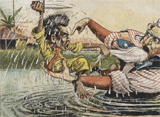Très long compte rendu de Ephraim Nissan sur deux ouvrages portant sur l’histoire de la caricature américiane
Lire l’article
Nissan,“Exploring Two Histories of American Political Cartoons. With a Digression” | 178
International Studies in Humour, 2(1), 2013 178
Exploring Two Histories of American Political Cartoons.
With a Digression: Late-19th-Century Treatments of the Theme “Immigrants from Europe’s Gutters” as Conveyed Visually, vs. Its Mocking by Parroting in Immigrant Literature (Tractate America)
Ephraim Nissan
Department of Computing, Goldsmiths‟ College, University of London, England, U.K.;
School of Arts, Histories and Cultures, The University of Manchester, England, U.K.
Review essay
Donald Dewey, The Art of Ill Will: The Story of American Political Cartoons. New York, NY: New York University Press, 2007. 251 pages. 238×236 mm. $34.95 (cloth). ISBN-13: 978-0-8147-1985-5; ISBN-10: 0-8147-1985-6
Stephen Hess and Sandy Northrop, American Political Cartoons: From 1754 to 2010. With a new chapter by the authors, New Brunswick, NJ: Transaction, 2011. 203 pages. 228×178 mm. (paperback). ISBN 978-1-4128-1119-4 [Augmented from Stephen Hess and Sandy Northrop, Drawn & Quartered: The History of American Political Cartoons, Elliott & Clark Publishing, 1996, itself a revision of: Stephen Hess and the late Milton Kaplan, The Ungentlemanly Art: A Hustory of American Political Cartoons, Macmillan Publishing Co., 1968, 1975.]
Abstract. Both books under review are deservedly classics, and they are complementary to each other. They are valuable both for the textual analysis they provide, and for the visual data (the political cartoons), of which the overlap is rather small: such a small overlap is made possible because Dewey‘s main source is the Granger Collection in New York (and most cartoons in his book are reproduced full-page). One can see how technical sophistication grew, from the American Revolution period, therough the Early Republic, to great sophistication already after the Civil War. Arguably, these books are not only important for cartooon or popular culture specialists. To illustrate the great contribution such material can make across disciplinary boundaries, the present essay shows how contemporary moods in New York City shaped both Frank Beard‘s anti-immigration cartoon of 1885, ―Columbia‘s Unwelcome Guests‖, and group self-deprecation and mock-parroting of the canard, namely, of the stereotypes that inspired Beard‘s cartoon, in the opening of his 1892 satire of immigrant life in New York City, Tractate America. The cartoon and the literary text interilluminate each other.
Keywords: Political cartoons; United States; History; Social conditions; Gerson Rosenzweig; Satire.
1. The Structure of the Two Books
2. The Textual Discussion in Dewey‘s The Art of Ill Will: A Commentary
3. Discussion in Hess and Northrop‘s American Political Cartoons
4. On Physical Features of a Few Presidents as Being ―Delectable Illustration Fodder‖
5. Animalisation: A Few Cases from the 1870s and 1880s
6. King Kong and his Ilk in Popular Culture and the Cartoons
7. Between Herblock‘s Perceptions and Perceptions of Herblock
8. A Case Study Across Media, Visual vs. Literary: Beard‘s 1885 Cartoon ―Columbia‘s Unwelcome
Guests‖, vs. Mock-Parroting of the Canard in Gerson Rosenzweig‘s 1892 Satire Tractate America
9. More about Frank Beard
10. Concluding Remarks
References
Nissan,“

